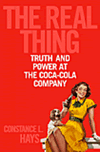| |
BOOK
REVIEW
The
real American fizz
The Real Thing: Truth and Power at the
Coca-Cola Company by Constance Hays
Reviewed by Chanakya Sen
For more than 100 years, Coca-Cola has
symbolized much more than a carbonated drink.
It has been an experience flowing over time
and space, a comforting souvenir of bygone
eras, "a bottle of optimism, the liquid
substitute for liberty beckoning toward the  American way". Constance Hays' biography
of the world's best-known brand romanticizes
the brown refreshment's vigor and sparkle and
at the same time highlights the murky
underworld of American big business.
American way". Constance Hays' biography
of the world's best-known brand romanticizes
the brown refreshment's vigor and sparkle and
at the same time highlights the murky
underworld of American big business.
The mentality of the Coca-Cola Co is the key
to understanding the shimmering successes and
despairing depths the brand has journeyed. Its
dedicated chief executive officers
"cannot sleep at night if they knew that
a store somewhere in the depths of the nation,
any nation, was not selling Coca-Cola".
The biggest soft-drink company in the world
already sells 310 billion bottles a year but
wants Coke consumption to keep on growing
endlessly. Company goals include vanquishing
not Pepsi-Cola, but substitutes for thirst
such as coffee, tea, milk and water. In
investor Warren Buffett's words, "having
everybody drink nothing but Coke" is the
overarching purpose. Marketers envisage a
360-degree landscape of Coke to increase the
global per capita consumption of the drink.
Bottlers are indispensable partners of the
company, delivering Coke to consumers through
franchises and sub-franchises in far-flung
corners. Bottling of Coke began in 1894,
replacing soda fountains. Early bottlers used
horses or mules to pull wagons of Coke,
catching the US consumerist boom. Bottlers
became important leaders within the social
hierarchy they occupied, "as indigenous
to the American scene as the post office or
the fire department". From Day 1,
disagreements and hostility raged between
independent bottlers and the company, which
supplied the syrup concentrate. Coke
executives felt they could gather greater cash
by selling in the company's own bottles.
Decades of litigation and mistrust led Coke to
unchain itself from the leaden bottling
system.
Bringing bottlers into line to satisfy the
company's control mindset was achieved in 1986
with the inauguration of Coca-Cola
Enterprises, a Coke-controlled mega-bottler
and consolidator. It gobbled up bottling
territories to concentrate more power in the
Coke tower in Atlanta, Georgia. Many
independent bottlers were forced to sign
revised contracts allowing frequent price
jack-ups for syrup. Coke's profit-sharing
percentage in bottler earnings rose under the
new setup. The company took 80% of the
profitability from the value chain and left
only 20% to the bottlers. Coke's soaring
profit margins in turn made it more attractive
for investors.
Mesmerizing Wall Street by painting upbeat
financial pictures of the company has been a
trademark of Coke chairmen. It ensured the
continuous rise of share price for years.
Economists were amazed by a company that sold
the same product for generations and yet had
"sexy growth" and unlimited
prospects - "a hot stock at the age of
100-plus". In trying to win over
financial analysts, marketing funds claimed an
ever-larger proportion of Coke's corporate
budget. Advertising touched US$2 billion by
2000, capitalizing on local market-specific
public consciousness.
In the 1960s, Coke's stock was a plodder,
generating solid returns but doing nothing
spectacular. A conservative percentage rise in
value per annum was not acceptable to Coke's
hubristic honchos of the 1980s and '90s, who
were dissatisfied with the idea of natural
growth. Coke had to be turned into a
"can't-miss stock" for investors to
come in running. Maintaining a marvelous
consistency of earnings by driving
possibilities to their limit contributed to
the ascent of Coke's share price.
Coke's role in uplifting the city of Atlanta
has been outstanding. As the company
blossomed, so did Atlanta, known as a confused
southern metropolis in American lore.
"Success of the Coca-Cola Co amounted to
a demonstration that Georgia can float and
handle big enterprises." Atlanta's image
in the world rose due to Coke. The 1996
Olympic Games bid succeeded because of the
company's behind-the-scenes lobbying of
Atlanta as a global player for bagging a
prime-time marketing chance. Coke's 1984 epic
centennial celebration cost US$30 million, the
world's grandest industrial birthday party,
and brought pride and wonder to Atlanta. No
tourist to Atlanta misses the World of
Coca-Cola Museum.
In 1985, Coke altered the legendary syrup
formula and introduced New Coke, a sweeter and
less fizzy drink, to shield consumers from the
spreading influence of Pepsi. The shame of
losing the No 1 position in the cola war to an
"upstart" was too awful and
humiliating for Coke's visionaries. The New
Coke gamble was motivated by blind taste
tests, where drinkers preferred the sweeter,
less sharp taste of Pepsi to Coke. However, it
turned into the biggest marketing flop in
modern business history. Dissenting Coke
executives themselves felt that New Coke
tasted just like Pepsi and was a disaster in
the making. Across the US, Coke loyalists rose
in indignation and demanded the old formula
back. Bottlers, even those singing the
company's tunes, rose up in arms. Just 78 days
after New Coke was unveiled, the company bowed
to universal pressure and brought back the
famed original Coke. New Coke threatened
briefly to bring the mighty Coke empire
crashing down.
In the 1990s, Coke penetrated emerging
overseas markets with foresight and planning.
Some 70% of the company's earnings came from
foreign sales by 10 large-scale "anchor
bottlers" that served like factories
printing money for the mother company.
Wherever circumstances presented new markets,
Coke was ready for them, rushing in to
exploit. The way Coke unplugged and pushed out
Pepsi from Venezuela in 1996 was a memorable
lesson in cutthroat competition. In exchange
for opening up, transition governments in
Eastern Europe and Central Asia used Coke's
presence as a stamp of political approval.
"If Coke was investing, they must be
doing something right."
By 1997, internal power wrangles and rivalries
emerged in the form of a tussle between two
distinct camps within the company - operations
executives who traveled the planet to sell
Coke, and financial experts who came from
accounting firms with management-consulting
backgrounds. Coke was also embroiled in
accusations of intimidating customers and
competitors through arrogant exclusive
agreements that aimed to exterminate all
rivals. To many, Coke's bullying restrictive
trade actions negated the notion of "an
America where people were entitled to a
choice". In 1998, France repealed Coke's
acquisition of Orangina as a monopolistic
purchase.
Coke's name figured in racial controversies
again and again. Black employees of Coke
sensed hostile and discriminatory work
environments. Only a handful of senior
executives were black and even they felt that
they were racially humiliated, ignored,
overlooked or unacknowledged. One black female
employee whooped, "Where am I? In the
'50s?" Blacks were clustered in the
lowest-paying jobs and confined to certain
lowly departments and roles. Coke pay scales
varied based on color. More than the lawsuits,
negative publicity on these counts hurt Coke's
self-projection as a simple "moment of
pleasure" for all manners of people.
The 1998 recession in Japan threw Coke's
fifth-largest and high-return market on to
the rocks. Germany, the fourth-largest, also
underwent depressed sales. The Russian ruble's
collapse came synchronously and drove Coke's
volume and earnings targets down for the first
time in ages. Indonesia, former Yugoslavia,
Latin America and India, all brought bad news
in earnings. The inflated Coke share price
tumbled after an exposť of its dubious
financial relationship with its mega-bottler.
A lawsuit alleging violations of antitrust
laws through restrictive marketing terms for
advertising signs, shelf and refrigerator
space forced Coke to pay $15.6 million in
damages. The attempt to take over Cadbury
Schweppes backfired through legal rejections
in Australia, Mexico, Canada and the European
Union.
By 1999, Coke was wobbling on five continents.
Belgium ordered an unprecedented removal of
Coke soft drinks from stores after several
schoolchildren reported sickness from drinking
them. The recall spread to other countries, as
Coke gave no plausible explanations for what
went wrong. In the end, it had to issue a
public apology to the people of Belgium.
Coke's benevolent image suffered yet again
when its chairman admitted that the company
was testing a new vending machine with
electronic capability to change prices based
on the weather. Another stock-price plunge
ensued.
With a cupful of woes, Coke's board of
directors fired the chairman. "Equivalent
of an assassination, [this] rocked the
company, alarmed Atlanta and unsettled Wall
Street." The troubled inside a global
giant was laid bare. Belief in the unlimited
growth of demand for Coke darkened. In a major
restructuring beginning in 2000, Coke was made
smaller and nimbler. A bid to acquire Quaker
Oats was scrapped. Some 6,000 workers lost
jobs and an about-turn was made by bringing
back a localized bottling network. "An
American icon crumbled."
Power intrigues, personality clashes,
over-ambition, twisted business tactics and
global economic fluctuations brought Coca-Cola
to its knees. Unlike Enron, WorldCom and
AT&T, though, Coke will inch its way back.
No matter how crooked its dealings, it is,
after all, a mirror of the American way of
life like no other. Real American fizz never
fizzles out permanently.
The Real Thing: Truth and Power at the
Coca-Cola Company by Constance Hays.
Random House, New York, 2004. ISBN:
0-375-50562-8. Price: US$25.95, 398 pages.
(Copyright 2004 Asia Times Online Ltd. All
rights reserved. Please contact [email protected]
for information on our sales and syndication
policies.) |
|
|
 |
|

 American way". Constance Hays' biography
of the world's best-known brand romanticizes
the brown refreshment's vigor and sparkle and
at the same time highlights the murky
underworld of American big business.
American way". Constance Hays' biography
of the world's best-known brand romanticizes
the brown refreshment's vigor and sparkle and
at the same time highlights the murky
underworld of American big business.


